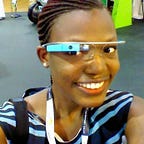A tale of two talks, joint talks, the Nigerian Passport and falling in love.
Earlier this year, I submitted three talks to Droidcon NYC because what’s the worst that can happen, right? The worst case scenario was that no talk would get accepted and I was getting quite used to that 😁. The best case scenario on the other hand, would be that one talk made it through. Nothing prepared me for what happened. TWO TALKS got accepted!
The first topic — Seeing is believing: Mobile Vision API Deep Dive was on a technology I had explored extensively and even written 3 articles about already. The second — No internet, no problem! was what Annyce and I did everyday at work; ensuring that our app works offline to serve our users regardless of their network conditions. While I was very familiar with both topics, I knew I had work to do.
🇳🇬n Passport
I didn’t confirm my speaker slot and didn’t even start work on my slides until I was sure I had a valid U.S. Visa although ideas were taking shape in my mind already. People with only one passport — the Nigerian one, will understand the struggle that comes with getting visas. 💔 Thankfully, Kevin Galligan and the rest of the team were really supportive and did a great job of ensuring that I had all the required documents in time.
Joint talks
Fortunately for me, Annyce Davis (btw, get you a manager like her) was really flexible throughout the whole process. She worked on most of the slides for our talk for two major reasons — she already had a draft and it made sense for us to continue building on that and I was also working on my solo talk, trying to ensure I had just the right amount of slides and relevant content on each of them. This was not my first joint talk though. I gave my first joint talk about Kotlin in a brownbag with Annyce in May and then another Kotlin talk with Segun Famisa in June this year at the I/O Extended event in Lagos.
From my experience with joint talks, there’s no one-size-fits-all approach to preparing. What I think matters is that the speakers agree on who makes what slides, how many times each person is going to speak and for how long, whether or not they’ll have joint rehearsals before then and most importantly, their collaboration tools.
For my Kotlin talk with Segun, we decided to split the presentation into two, with him speaking entirely during the first half of the talk. I spoke briefly, did a codelab and wrapped up the talk. We worked with Google Slides so our collaboration was seamless. After we had concluded on the content of the slides (which consisted mostly of text and code snippets), we picked a theme to maintain consistency. Our goal was to ensure that people reading the slides after the talk would not be able to tell where the first half of the talk ended and the next started. We also didn’t have joint rehearsals since each person trusted the other not to exceed the time limit.
Preparations were slightly different for my talk with Annyce. Our slides were created in Keynote and collaboration was done via iCloud. Since we were speaking about stuff we did at work daily and she already had a template, it was very easy for us to prepare the talk. We planned to divide the talk into sections, with each person speaking about a main point before passing the baton to the other. We had joint rehearsals over Zoom twice and there, we discovered portions of the presentation we needed to flesh out. After our second rehearsal which lasted for thirty minutes, we found that we had time left to take a few questions after the talk.
Two talks
Even if you already have what to say, preparing a talk is hard work. That’s why I think some speakers repeat the same talk a couple of times. Tell me about using appropriate fonts and font sizes and ensuring that there’s enough contrast between them, including just enough descriptive images to help your audience grasp your content easily and to help you remember what to say, eliminating bullet points if you can, ensuring that your code doesn’t compile on your slides e.t.c. Shoutout to Virginia Poltrack for helping out again with all the illustrations.
At ninety-five pages, my slides for the Mobile Vision API talk were the maximum number I had ever drawn up for any talk. I wanted to show and tell during the presentation so I had to include photos and a gif showing demos of the different functionalities of the API. I also had a group of reviewers look through and help point out any areas they thought could be better.
Droidcon NYC held on two days and I had one talk on each of those days. The Mobile Vision API one was on the first day after lunch. I got into the flow after a few minutes but I had to rush a bit through the end of the presentation when the yellow card (which represented the five minutes I had left to conclude) was held up at the back of the hall. All the pressure I was feeling reduced drastically after the first talk and I ended my day at the Spotify party with Ifeoma Okereke, early enough to grab some food before it ran out. 🍕 🥗
I’m happy I took on the challenge and I’m very grateful for the opportunity. I met a couple of friends from the internets (read Twitter).
I also met Android developers whose names and libraries I see in my Android projects everyday. It was super cool meeting the creator of the Evernote Android Job library in person.
